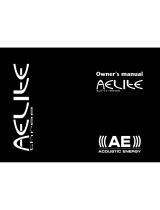Page is loading ...

Owner’s manual
AEGIS three manual 15/6/99 12:48 pm Page 1

Congratulations on choosing the Acoustic Energy AEGIS
THREE — a powerful floorstanding three-way loud-
speaker which features metal diaphragm technology
and is capable of outstanding performance. Please take
a few moments to read this manual. The advice it
contains will enable you to get the very best perfor-
mance out of your Acoustic Energy loudspeakers.
The AEGIS THREE utilises metal cone mid drive unit technology,
proven in the AE Reference series. The rigid anodised alloy cone
ensures pure piston action and also acts as a heat sink for the
bonded voice coil. These features provide exceptional clarity,
transparency dynamics and power handling.
The LF unit incorporates a larger polypropylene cone with a
critical flare which gives efficiency and rigidity to ensure a con-
trolled yet fast bass response. It is housed within a vented
polymer chassis reducing stray magnetic flux to a minimum
and increasing power handling.
The tweeter — or treble driver — is a high-quality silk fabric
dome unit integrating smoothly with the rest of the system.
All drive units are fully magnetically shielded so that the
speakers can be used in close proximity to a TV screen or
monitor for AV applications.
The AEGIS THREE loudspeaker uses high quality OFC internal
wiring which enhances detail and transparency. For exceptional
results use AESC-C3 speaker cable which is available from AE
dealers and distributors.
Please unpack your AEGIS THREEs carefully. Locate the plinths
and fittings and, having carefully inverted the speaker, screw the
plinth to the base of the cabinet using the screws and pilot holes
provided. Please take extra care during this operation as the
cabinet is top-heavy when inverted. Please also ensure that you
have tightly screwed the plinth to the cabinet, failure to do this
will affect performance.
High tensile 8mm floor spikes and lock-nuts are provided for use
with the plinth. These guarantee optimum coupling to the floor
particularly in rooms fitted with carpet. The spikes penetrate the
carpet and couple the speaker firmly to the floor structure below.
The spikes (with lock-nut screwed down to the knurled part of
the spike) should be fitted to the threaded insert in the underside
of the plinth while the speaker is still inverted. The speaker is
now ready for installation. Any final adjustment of spikes to
eliminate cabinet wobble can now be made using a spirit level if
required. The lock nuts should be tightened when the final
adjustments to cabinet position and alignment have been made.
Closeness to room boundaries has a major impact on the low fre-
quency performance. The speakers should be kept away from
corners (which will produce booming) and there should be at least
a 300–400mm (12–16 inch) gap from any back or side walls.
Experiment with the best position to achieve a full, yet clean
bass response. Trust your judgement and ears. For serious listen-
ing the grilles are best removed.
For best stereo imaging the speakers should be as far apart as
they are from the listening position.
Introduction Positioning
AEGIS three manual 15/6/99 12:48 pm Page 2

Check that your amplifier is switched off before installing your
loudspeakers. Failure to do so may result in speaker or amplifier
damage. The diagrams illustrate one loudspeaker only.
Conventional
Normal passive wiring requires shorting links to be in place
between the treble and mid/bass sections. The positive (ribbed)
cable from the amplifier positive (or red) terminal should
connect with the positive (red) terminal on the loudspeaker.
Similarly the negative (smooth) cable should connect the ampli-
fier negative terminal (black) to the negative terminal (black) on
the loudspeaker.
Bi-wiring
Bi-wiring separates the bass and treble ground paths in the loud-
speaker and offers great sound quality advantages. An extra set
of cables is required. Note that the shorting links are removed
between the treble and mid/bass sections and should be stored
for later use if conventional, passive driving is required.
Two pairs of cables are connected to the amplifier terminals.
One cable of each pair should connect to the HF or treble section
and one to the LF or bass section. The positive (ribbed) cables
from the amplifier positive (or red) terminal should connect with
the positive (red) terminals on the loudspeaker. Similarly the
negative (smooth) cables in each pair should connect the ampli-
fier negative terminal (black) to the negative terminals (black)
on the loudspeaker.
Bi-amping
Bi-amping adds a second amplifier to the system. One power
amplifier drives the treble section of both loudspeakers; a second
drives the mid/bass sections.
As regards the loudspeakers, wiring for bi-amping is achieved in
much the same way as bi-wiring. Treble amplifier positive (red)
terminal should be connected via the ribbed cable to the positive
(red) HF terminal on the
speaker. Similarly,
treble amplifier
negative is connected to
the negative (black) HF
terminal on the
speaker. Repeat this
process with the bass
amplifier and
LF terminal
pair.
After wiring
up
Lower the
volume to
minimum,
switch on the
amplifier,
select the
signal source
and then raise
the volume to
the listening
level required.
Connection
AMPLIFIER
RIGHT SPEAKER
RETAIN LINKS
FOR FUTURE USE
R
L
MAIN
AEGIS three manual 15/6/99 12:48 pm Page 3

Specifications
HF unit 25 mm silk fabric dome, anti-reflec-
tion pole. Ferrofluid cooled and
damped. Magnetically shielded
MF unit 130 mm chassis, alloy cone, with
32 mm coil, high-power, long-throw
magnet system. Magnetically shielded
LF unit 180 mm vented polymer chassis,
critically shaped polypropylene
cone, with long-throw magnet
system. Magnetically shielded
Crossover 3-way, 8 element 12dB/octave slope
at 350 Hz and 3.2 kHz. High power
inductor for bass. High quality OFC
wire to drive units
Power handling 30 – 150 watt max
Overall frequency response 33 Hz – 22 kHz (38 Hz – 20 kHz ±3 dB)
Sensitivity 90 dB/1 w/1 m
Impedance 8 ohm
Cabinet 15 mm MDF, full circumferential
brace, gas-flowed, low-turbulence
bass reflex ports. 25 mm MDF front
baffle. Mass loaded
Terminals Gold-plated bi-wireable binding posts
Weight (excl. packaging) 16 kg each
Dimensions (WxHxD) 192 x 880 x 220 mm
Warranty
Your Acoustic Energy loudspeakers are guaranteed against original
defects in materials, manufacture and workmanship for 3 years from
the date of purchase. Please retain all original packaging materials for
possible future use. We suggest that you complete details of purchase
now and keep this information in a safe place for future reference.
Under this warranty Acoustic Energy agrees to repair any defect or,
at the company’s discretion, replace the faulty component(s) without
charge for parts and labour. This warranty does not imply any
acceptance by Acoustic Energy or its agents for consequential loss or
damage and specifically excludes fair wear and tear, accident,
misuse or unauthorised modification.
This warranty is applicable in the United Kingdom only and does not
in any way limit the customer’s legal rights. Claims and enquiries
under the warranty for AE products purchased outside the UK should
be addressed to the local importers or distributors.
If you have reason to claim under the warranty please contact your
dealer in the first instance.
Dealer’s name:........................................................................................
Address: ..................................................................................................
................................................................................................................
................................................................................................................
Date of purchase: ...................................................................................
Serial numbers: ......................................................................................
Acoustic Energy Limited
16 Bridge Road, Cirencester
Gloucestershire GL7 1NJ
Tel +44 (0)1285 654432
Fax +44 (0)1285 654430
AEGIS three manual 15/6/99 12:48 pm Page 4
/











